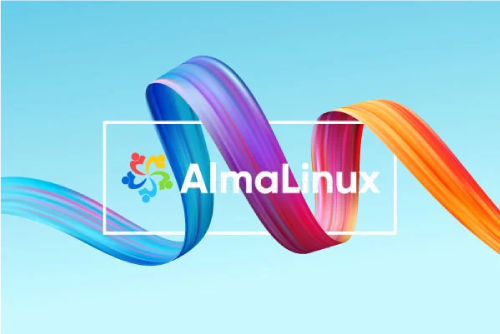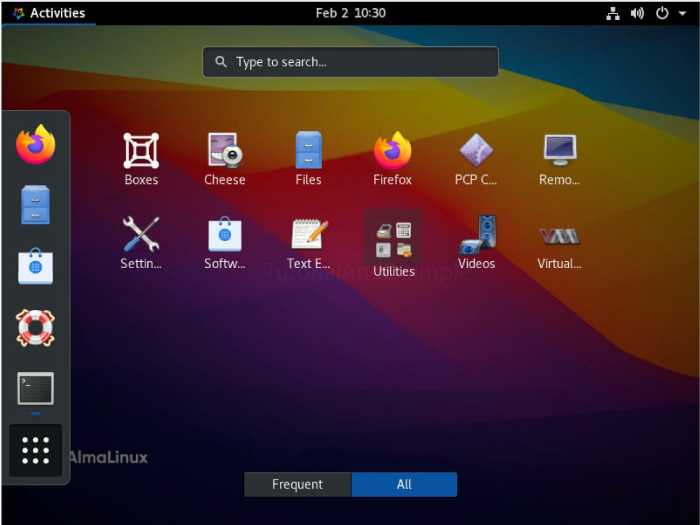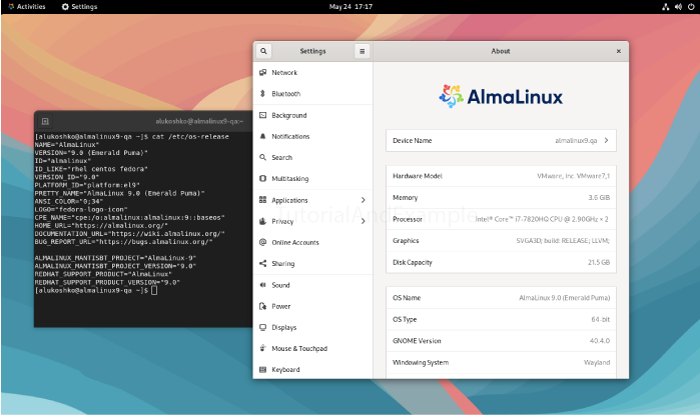Alma Linux
What is Alma Linux?
Alma Linux OS Foundation is a 501(c) organization established to develop the Alma Linux distribution; it is a free and open source Enterprise grade production-ready OS that claims to be binary compatible with Red Hat Linux RHEL . The word ' Alma,' which in Spanish and other languages that consist of Latin origin, is the meaning for 'soul,' is the term coined for the distribution. It was decided to make the reward for the Linux community.
The initially stable version of Alma Linux was launched on March 30, 2021, and will be supported till March 1, 2029. The Alma Linux Build System (ALBS) is a slightly altered build system that comprises of a complete open source code basis of Alma Linux whose build process is visible and is built through open methods.

Past Events
Red Hat declared on December 8, 2020, that CentOS, a free downstream spin-off of the commercial Red Hat Enterprise Linux ( RHEL), was no longer going to be developed and official support to it would cease in April 2024 in favor of CentOS Stream, which is similar A new stream version of CentOS from the same parent RHEL will be CentOS Stream, the distro that Red Hat uses to test new features for future RHEL releases.
Thus, Cloud Linux that runs Cloud Linux OS its own paid distribution declared supporting Alma Linux in creating the community-supported spiritual successor to CentOS Linux aimed at achieving the binary compatibility with the latest RHEL release. Nevertheless, on February 1, 2021, Alma Linux was made available in beta form, and on March 30, 2021, the first stable version of Alma Linux was made available. Up until Fiscal Year 2029, Alma Linux 8. x will be maintained. It is also backed by a number of businesses being ARM, AWS, Equinix as well as Microsoft.
Thus, Cloud Linux, which initially pledged 1M USD per year for the project’s sustenance, was deprived of the Alma Linux development and management rights on March 30, 2021, when the company turned the Alma Linux OS project into the Alma Linux OS Foundation with 501(c) status. Due to the release of Alma Linux 8, the Alma Linux OS Foundation rolled out the Alma Linux Build System (ALBS) on June 20, 2022.
Alma Linux OS Foundation on September 19, 2022, posted on their website that the community will elect seven members, and they'll be elected in September 2022. Igor Seletskiy, Cloud Linux's CEO and the former chair of the board stated in an interview shortly after the election that he would be happy to resign from his position to let Alma Linux remain as a community distribution. The board then elected Benny Vasquez as the new chair of the board.

On December 7, 2022, it was unveiled that Alma Linux, which is the standard operating system used in CERN and Fermilab investigations, would be released. It was on July 14, 2023, three weeks after Red Hat notified the public on June 21, 2023, that more limitations had been placed on their code that Alma posted a response on their blog which said thus: ‘The board of the Alma Linux OS Foundation has decided to not pursue a 1:1 parity with RHEL’. However, Alma Linux OS should attempt to be binary compatible with the RHEL version instead of being source code compatible.
The Alma Linux OS Foundation conducted its second election in December of 2023 and consequently added CERN's Alejandro Iribarren and Cybertrust Japan's Jun Yoshida to the board. This means while the Foundation had proclaimed in September 2023 they were expanding the board.
Elevate Project
On September 1, 2021, the Alma Linux project stated that it is going to be feasible to perform in-place updates between enterprise Linux distributions with distinct points within release versions, primarily due to Elevate. “Elevate is intentionally provided as a utility for the whole ecosystem rather than solely for Alma Linux and is implemented as such; Elevate is open and developed to be better, letting users migrate to and from other distributions.” They added more repositories to the tool in January 2024, while in April 2024 users were allowed to in-place upgrade from CentOS 6 to 7 using their preferred corporate Linux version 9.
Construct a System
The method of building Alma Linux is considered the Alma Linux Build mechanism, or ALBS for short. Specifically, it can help develop items for the x86-64, AArch64, ppc64, and S390x platforms. It was initially used in the delivery of version 8. 6 (Sky Tiger). ALBS is made up of the Git Service, Release System, Sign Server, Test System, and Build Node. Each of them has a supervision of the Master Service, named as a component-to-be-managed, which is expected to be managed by its API.
Git Support
Thus, Git code repositories of the Red Hat Enterprise Linux software package are the direct source of Alma Linux code. The Alma Linux Git Service retrieves its source code to a copy disposed of on its own publicly reachable Gitea server instance through a “listener” that monitors the changes in the existing repositories or the creation of new ones. One can also take a peek at the build pipelines of each package implemented on the web interface of this public server. In addition, the service shall ensure that repositories are available in the rest of ALBS as soon as an API exposes it.
Construct Node
According to the Master Service, the role of Build Node is to perform compilation of the source code out of the Git repositories into the subsequent RPM packages that can be used during the installation of the distribution. These components have a particular kind of storage as build artifacts where they can be dealt with further.

Test Framework
Bags of RPM that are created as a result of builds are tested for functioning using the Alma Linux Test System (ALTS). Containers are applied to provide specific environments where test suites for packages can be run. The sign server and the release system are currently in place.
All packages intended for using with the Alma Linux distribution are signed with the help of Pretty Good Privacy cryptographic protocol to ensure package integrity. The only input the Sign Server receives from the Build Node is actual artifacts that are taken for signing and, after which, are placed back into the artifact storage. All of these can be uploaded to the release repositories through the Release System.
Conclusion
Therefore, Alma Linux is a highly stable and secure Linux distribution developed by the community from scratch for organizations and developers in search of a rocky CENTOS substitute.